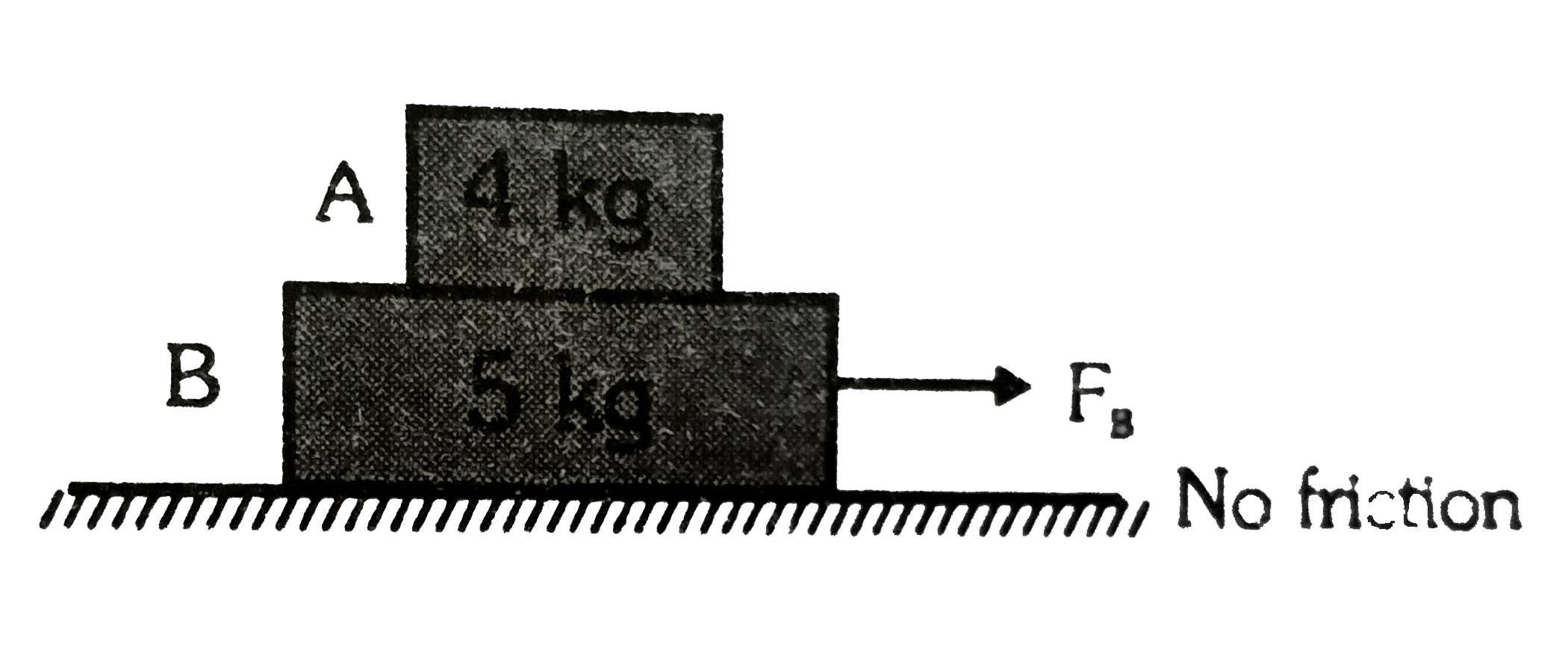A 4 kg block A is placed on the top of 8 kg block B which rests on a smooth table.

A just slips on B when a force of 12 N is applied on A. Then the maximum horizontal force F applied on B to make both A and B move together, is
12 N
24 Ns
36 N
48 N
The correct Answer is:B
(b) When force is applied on A, acceleration produced will be
FAmA+mB=μmAgmB…(i)
When force is applied on B, acceleration produced will be
FBmA+mB=μmAgmA….(ii)
Dividing these two equations, we get FBFA=mBmA
∴ FB=mBmA.FA=84×12=24N
Topper's Solved these Questions
- LAWS OF MOTIONBOOK - DC PANDEYCHAPTER - LAWS OF MOTIONEXERCISE - Assertion and reason
28 Videos
- LAWS OF MOTIONBOOK - DC PANDEYCHAPTER - LAWS OF MOTIONEXERCISE - Match the columns
7 Videos
- LAWS OF MOTIONBOOK - DC PANDEYCHAPTER - LAWS OF MOTIONEXERCISE - Check point 5.4
20 Videos
- KINEMATICS 1BOOK - DC PANDEYCHAPTER - KINEMATICS 1EXERCISE - INTEGER_TYPE
15 Videos
- LAWS OF THERMODYNAMICSBOOK - DC PANDEYCHAPTER - LAWS OF THERMODYNAMICSEXERCISE - Level 2 Subjective
18 Videos
Similar Questions
A4 kg blocks A is plced on the top of 8 kg block B which rests on a smoth table .A just slips on B when a force of 12 N is applied on B to make Both A and B move together is (4x) N Find the value of x.
View Solution12N of force required to be applied on A to slip on B. Find the maximum horizontal force F to be applied on B so that A and B moves together.

View Solution
Knowledge Check
A 4.0 kg block is put on top of a 5.0kg block. In order to cause the top block to slip on the bottom one, a horizontal force of 12N must be applied to the top block. Assuming a friction less table the maximum horizontal force F which can be applied to the lower block so that the blocks, will move together should be
 A<30NB<27NC<15ND<9N
A<30NB<27NC<15ND<9N
Two blocks A and B are shown in figure. The minimum horizontal force F applied on Blocks B for which slipping begins at B and ground isA100 NB120 NC50 ND140 NA 3 kg block is placed over a 10 kg block and both are palced on a smooth horizontal surface. The coefficient of friction between the block is 0.2 . If a horizontal force of 20 N is applied to 3 kg block, accelerations of the two block in ms−2 are (take, g=10ms−2)
 A134,0.6B144,3C134,3D143,0.6
A134,0.6B144,3C134,3D143,0.6
A block the of mass 4kg is placed on another block of mass 5kg and the block B rests on a smooth horizontal table for sliding the block A on B a horizontal force 12N is required to be applied force on it How much maximum horizontal force can be applied on 'B' s that both A and B move together? Also find out the accleration proudced by this force
 .
.
View SolutionA 5 kg block is placed on the top of a 15 kg block as shown in figure . A horizontal force of 60 N is applied to the 15 kg block and the 5kg block is tied to the wall . The coefficient of friction between moving surfaces is 0.2

(a) Draw the free body diagram for each block w.r.t ground and identify the action reaction forces between two blocks .
(b) Determine the tension in the string and magnitude of the acceleration of the 15 kg block .
View SolutionThe coefficient of static friction between the two blocks shown in figure is μ and the table is smooth. What maximum horizontal forced F can be applied to he block of mass M so that the block move together?

View SolutionA 3kg block is placed over a 10kg block and both are placed on a smooth horizontal surface. The coefficient of friction between the blocks is 0.2. IF a horizontal force of 20N is applied to 3kg block. Find the acceleration of the two blocks.

View SolutionA block of mass 4 kg is resting on a horizontal table and a force of 10 N is applied on it in the horizontal direction. The coefficient of kinetic friction between the block and the table is 0.1. The work done in √20 s
View Solution
